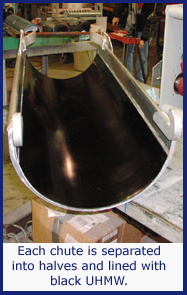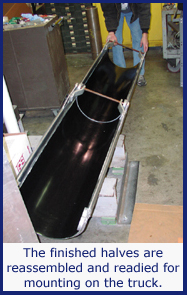|
New Applications for Bondable UHMW-PE
Thin-gauge Ultra High Molecular Weight Polyethylene
(UHMW-PE) was first introduced to the plastics
industry during the 1970s. At the time there were
few distributors marketing the product and few who
understood its potential. But word spread as manufacturers
and distributors alike experimented with applications.
Support grew. Now, new uses for this durable plastic are
floated through the marketplace every day.
What’s so special about UHMW-PE? Why has demand
for the product increased so rapidly over the last few
decades?
The answers are pretty simple. With a molecular weight
ten times greater than standard HDPE resins, UHMW-PE
has the highest abrasion resistance of any thermoplastic
polymer. It also has a low coefficient of friction, displays
great impact strength (even at low temperatures) and is
extremely wear resistant and chemical resistant. Yet,
UHMW-PE is easily machined, making it a top choice for a
broad range of applications. Shims, wear plates, wear strips,
gaskets, washers, door and drawer glides, scrapers and doctor
blades are all common, widespread uses for UHMW-PE.
However, there was one development in particular that
opened a whole new world of previously unforeseen
opportunities: the creation of bondable UHMW-PE. The
tough, slick plastic could now be directly applied to a surface
without the use of mechanical fasteners. Thin, adhesive-
backed UHMW tape began making its way onto distributor
shelves. And where a quarter-inch layer of UHMW
once required riveting (or countersinking) to hold it in
place, a flexible layer of adhesive-backed .062” could provide
the same service with more wear surface.
 It was less
expensive, covered the application area more effectively
and was easier to install.
It was less
expensive, covered the application area more effectively
and was easier to install.
Here’s just one example of how bondable UHMW is
being used in heavy industry.
Harrison Concrete of Harrison, Ohio, wanted to improve
material flow in the delivery chutes of their concrete mixing
trucks. They were looking for chute liners that were easy to
install and clean – but slick enough to move heavy, wet concrete.
They also wanted material that would install without
the use of fasteners. Seams, rivets and bolts in the liner
cause the concrete mix to aggregate, clogging the funnel.
Crown Plastics (also of Harrison) was just around the
corner. The two companies worked together to design a
previously untested solution.
In the spring of 2007 Crown engineers covered the delivery
chutes of two mixing trucks with 4’ strips of 20” wide,
.125” gauge black UHMW (black was chosen for its resistance
to UV light). Each truck chute consists of two hinged
“halves.” The halves were separated and carefully cleaned
 and dried. Since UHMW has low surface energy, the material
was flame oxidized to
prepare it for bonding.
Then a two-part epoxy
was applied to the chute
and the UHMW was
pressed into place and
trimmed. Clamps held
everything in place while
the application cured.
and dried. Since UHMW has low surface energy, the material
was flame oxidized to
prepare it for bonding.
Then a two-part epoxy
was applied to the chute
and the UHMW was
pressed into place and
trimmed. Clamps held
everything in place while
the application cured.
In just a few days the
trucks were ready to be
put back into service.
Harrison Concrete
employees spent the
next several months
observing the product
liner’s performance in the
field. Material flow and
clean-up were monitored.
Careful attention
was paid to the treatment’s
resistance to
moisture and abrasion.
Wear and tear on the
adhesive bond was also
studied.
The application is still
in the experimental
stages and tests will continue
for a few more
months. But initial results
appear favorable and the
process has already
proven successful in
other industries. Thingauge
UHMW is used to
reduce friction and wear in a wide variety of applications
including on hoppers, conveyor systems, skateboard decks
and boat bottoms to name a few.
For more information, on thin-gauge, bondable
UHMW, contact Crown Plastics, 116 May Dr., Harrison,
OH 45030, 800-368-0238, Fax: 513-367-4004, Web:
www.crownplastics.com and www.durasurf.com.
|